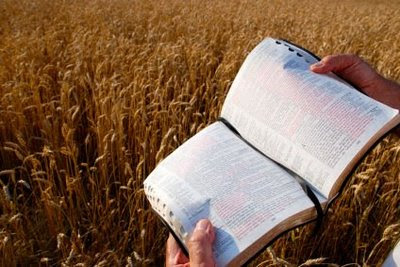

SEEDING-When the soil was prepared, the seed was sown broadcast over the field ( Matthew 13:3-8). The oxen were urged on by a “ goad,” or long staff pointed at the end, so that if occasion arose it could be used as a spear also ( Judges 3:31 1 Samuel 13:21). Men sometimes followed the plow with a hoe to break the clods ( Isaiah 28:24). They were drawn by oxen ( Job 1:14), cows ( 1 Samuel 6:7), and asses ( Isaiah 30:24) but an ox and an ass must not be yoked together in the same plow ( Deuteronomy 22:10). They were light, and required great attention to keep them in the ground ( Luke 9:62). Simple plows were known in the time of Moses ( Deuteronomy 22:10 compare Job 1:14).

PLOWING-The sculptured monuments and painted tombs of Egypt and Assyria throw much light on this subject, and on the general operations of agriculture.

Tisri, former half., harvesting of fruits. Nisan, latter half (Beginning about vernal equinox. Latter rain due ( Deuteronomy 11:14 Jeremiah 5:24 Hos. Tisri, latter half (beginning about the autumnal equinox.)Įarly rain due = first showers of autumn. Widows, orphans and the poor were permitted to claim the corners of the fields and the gleanings.Ī forgotten sheaf in the field was to be left also for the poor. It was forbidden to sow a field with diverse seeds ( Deuteronomy 22:9).Ī passerby was at liberty to eat any quantity of corn or grapes, but he was not permitted to carry away any ( Deuteronomy 23:24-25 Matthew 12:1). YEAR OF REST-Lest the productiveness of the soil be exhausted, it was decided that the whole land should rest every seventh year, when all agricultural labor would entirely cease ( Leviticus 25:1-7 Deuteronomy 15:1-10). operations-agricultural implements and operations.The wheat sometimes produced hundredfold ( Genesis 26:12 Matthew 13:23).įigs and pomegranates were very plentiful ( Numbers 13:23), and grapes and olives grew luxuriantly and produced abundant fruit ( Deuteronomy 33:24). Wheat was also sent in large quantities to the Tyrians for the merchandise in which they traded ( Ezek. The extensive and easily-arranged system of irrigation from the rills and streams from the mountains made the soil in every part of Israel richly productive ( Psalm 1:3 65:10 Proverbs 21:1 Isaiah 30:25 32:2, 20 Hosea 12:11), and careful cultivation and application of manure increased its fertility to such an extent that in the days of Solomon, when there was an abundant population, “20,000 measures of wheat year by year” were sent to Hiram in exchange for timber ( 1 Kings 5:11). The 6 months from the middle of Tisri to the middle of Nisan were occupied with the work of cultivation, and the rest of the year mainly with the gathering in of the fruits. Agriculture became the basis of the Mosaic commonwealth. After the Israelites gained possession of the Promised Land, their circumstances were ideal for a remarkable development of this art. Tilling the ground ( Genesis 2:15 4:2-3, 12) and rearing cattle were the main employments in ancient times.


 0 kommentar(er)
0 kommentar(er)
